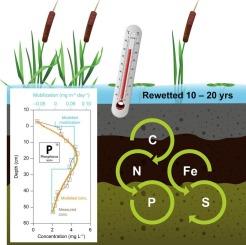A comprehensive porewater survey of European peatlands reveals sustained elevated phosphorus levels after 10–20 years of rewetting
IF 6.6
1区 农林科学
Q1 SOIL SCIENCE
引用次数: 0
Abstract
Rewetting drained peatlands can lead to high nutrient mobilization, increased methane emissions, and a slow re-establishment of peat-forming vegetation. To guide effective restoration and management, understanding the temporal and spatial variability in porewater chemistry is essential. This study surveyed 64 natural and rewetted peatlands across Germany, Poland, Estonia, Sweden, Georgia, and Scotland from 1997 to 2017. A total of 812 anoxic porewater samples were collected using dialysis samplers (0–0.6 m depth). The rewetted fens exhibited a wide range of dissolved substances, spanning orders of magnitude for soluble reactive phosphorus (SRP: 0.1–18.9 mg L−1), ammonium (NH4+-N: 0.1–117.3 mg L−1), and dissolved organic carbon (DOC: 13–313 mg L−1). However, the mean concentrations were significantly higher than those observed in natural fens (p < 0.05). Depth-integrated mobilization rates for nutrients in rewetted fens were, on average, 23 times higher for SRP (1.8 mg P m−2 d-1) and 4.6 times higher for NH4+-N (3.6 mg N m−2 d-1) compared to their natural counterparts (0.1 mg P m−2 d-1 and 0.8 mg N m−2 d-1). Seasonal variation was also evident in rewetted fens densely colonized by helophytes, with SRP concentrations being lower in the growing season. Notably, SRP concentrations remained elevated 10–20 years after rewetting; however, a 50–80 % decrease was observed at sites characterized by comparatively low iron content in the peat (< 20 mg g−1 dry mass). Further investigations should explore how nutrient dynamics evolve over extended rewetting periods in different contexts, including climate change.

一项对欧洲泥炭地孔隙水的全面调查显示,经过10-20年的再湿润,磷含量持续升高
排水泥炭地的再湿润会导致高养分动员、甲烷排放增加以及形成泥炭植被的缓慢重建。为了指导有效的恢复和管理,了解孔隙水化学的时空变化是必不可少的。这项研究调查了1997年至2017年德国、波兰、爱沙尼亚、瑞典、格鲁吉亚和苏格兰的64个自然和再湿润的泥炭地。采用透析采样器(0 ~ 0.6 m深度)共采集缺氧孔隙水812份。复湿泥沼的溶解物质范围广泛,包括可溶性活性磷(SRP: 0.1 ~ 18.9 mg L−1)、铵(NH4+-N: 0.1 ~ 117.3 mg L−1)和溶解有机碳(DOC: 13 ~ 313 mg L−1)。但平均浓度显著高于天然沼气池(p < 0.05)。在复湿的沼沼中,与天然沼沼(0.1 mg P m−2 d-1和0.8 mg N m−2 d-1)相比,SRP (1.8 mg P m−2 d-1)和NH4+-N (3.6 mg N m−2 d-1)的养分深度综合动员率平均高23倍。在植生植物密集分布的复湿沼泽中,季节变化也很明显,生长季节SRP浓度较低。值得注意的是,再湿润后10-20年,SRP浓度仍然升高;然而,在泥炭中铁含量相对较低的地方(干质量为20 mg g - 1),观察到50 - 80%的减少。进一步的研究应该探索在不同的背景下,包括气候变化,营养动态是如何在延长的再湿润期中演变的。
本文章由计算机程序翻译,如有差异,请以英文原文为准。
求助全文
约1分钟内获得全文
求助全文
来源期刊

Geoderma
农林科学-土壤科学
CiteScore
11.80
自引率
6.60%
发文量
597
审稿时长
58 days
期刊介绍:
Geoderma - the global journal of soil science - welcomes authors, readers and soil research from all parts of the world, encourages worldwide soil studies, and embraces all aspects of soil science and its associated pedagogy. The journal particularly welcomes interdisciplinary work focusing on dynamic soil processes and functions across space and time.
 求助内容:
求助内容: 应助结果提醒方式:
应助结果提醒方式:


